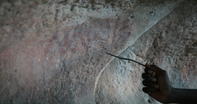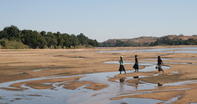Zhizo Culture at Schroda (900 AD to 1000 AD)
900 AD is acknowledged as the start of the Late Iron Age in southern Africa. There is still considerable debate about whether or not there was ever a Middle Iron Age, but I’ll leave that one to the academics.

For our purposes, we can just say that, by 900 AD, a new group had settled in the Limpopo-Shashe basin: the Zhizo people. They originated in what is now southwest Zimbabwe and eastern Botswana, but a section of this population subsequently moved south over the Limpopo and established a capital at a place called Schroda.
The reasons for this move are unclear. Some archaeologists say that the rainfall had improved in the region and this allowed the farmers to return. Others say that things only got wetter about 100 years later. Thomas Huffman, on the other hand, has suggested that it was the lure of elephants and ivory that drew the Zhizo people across the river.
Ivory Trade
Ivory trading was evident between Zimbabwe and the East Coast from 800 AD, so the value of this commodity had already been established. There has always been (and still is) a plentiful supply of elephants around the Limpopo and this would therefore guarantee a reliable source of White Gold. An elephant-centric lifestyle would also explain why most of the Zhizo settlements are located away from the river, where the thirsty elephants would have trampled their crops.
Furthermore, Schroda contains the first evidence of ivory working in the basin, which shows that the Zhizo people were crafting ivory objects for trade. Exotic glass beads were also found at the site, and this indicates that the Zhizo had connections with the Arabic trading stations on the East Coast (located around the Bazaruto Archipelago of Mozambique) There are a number of Zhizo settlements around the Shashe-Limpopo basin, but Schroda is the largest.
Therefore, it is assumed to be to be the home of the wealthiest chief and thus the capital city. The size of this ‘capital’ has been estimated to be between 300 and 500 people, with another 1400 people living in surrounding homesteads.
A Sophisticated Community

The Zhizo culture was evidently quite sophisticated. They kept cattle and livestock, and harvested and stored grains. Archaeologists have also uncovered a number of unusual clay figurines that depict animals, humans and some fantastic creatures that defy identification.
It is thought that these figurines were part of a female initiation school, and were used to demonstrate lessons about life, love and duty. This is a tradition that was widespread throughout Southern Africa. Today, there are no physical signs of the Schroda settlement, and visitors are not allowed to go to the (unmarked) site without a guide and special permission.
It is hoped that the site will be opened to the public once the fragile environment has been stabilised and protected. Schroda is located within the boundaries of the Mapungubwe National Park, just a short distance to the east of Mapungubwe Hill itself.
By David Fleminger